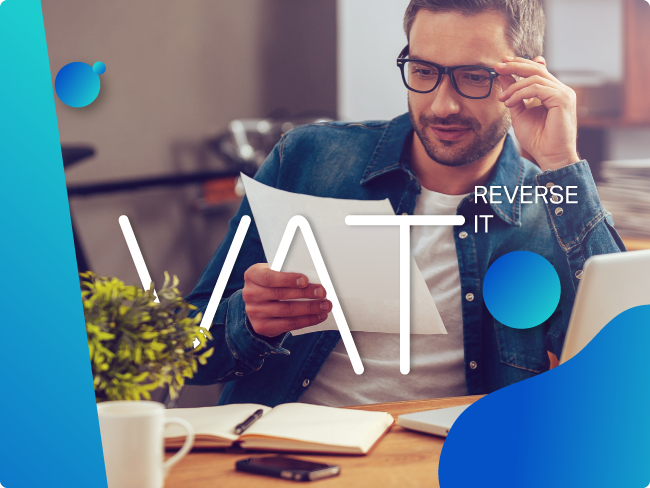What is a reverse charge VAT invoice?
A reverse Value Added Tax (VAT) invoice is issued in special cases where transactions are subject to the VAT reverse charge mechanism.

A reverse Value Added Tax (VAT) invoice is issued in special cases where transactions are subject to the VAT reverse charge mechanism.
For many businesses, understanding how a reverse charge VAT invoice works may be necessary for you to undertake certain transactions and comply with the relevant VAT compliance rules. Businesses in the EU that supply goods and services to businesses located in other EU countries are likely to encounter the VAT reverse charge mechanism fairly often.
The VAT reverse charge is unusual in that the customer accounts for the VAT. In order to remain VAT compliant and avoid penalties, therefore, companies on both sides of the transaction need to understand how VAT reverse charges works. It is also in the interest of both supplier and customer to ensure an accurate, appropriate reverse charge VAT invoice is issued.
Examples of VAT reverse charges in practice
So, how does VAT work with reverse charges? Let’s consider VAT reverse charges in the supply of goods within the EU. A business located in Germany sells cotton to a factory in Slovakia that produces denim shirts.
Assuming both the seller and the buyer are VAT registered taxable persons within the VAT registration threshold, the buyer (the shirt factory) accounts for the VAT. The German wholesaler, in this case, does not have to register for VAT in Slovakia and is not required to deal with the local tax authorities.
Similarly, consider a Spanish company that supplies VAT accounting services to a business located in the Netherlands. If the Spanish firm providing the services is not established in the Netherlands, then the customer accounts for the VAT.
In each case, a valid reverse charge VAT invoice must be issued.
Note that the VAT reverse charge mechanism only applies in the case of B2B transactions between a business that is registered for VAT to another. If a VAT registered business sells goods or services to an individual located abroad for their personal use, then the reverse charge rules do not apply and the normal VAT rules apply. In such cases, the supplier charges and accounts for paying VAT, as in most ordinary transactions.
When domestic reverse charges VAT invoices are issued
For companies based in the EU engaged in the supply of goods and services on a B2B basis to other companies in Europe, the EU vat reverse charge mechanism outlined above is likely to be the most commonly encountered scenario in which a reverse charge VAT invoice needs to be issued.
But note that VAT reverse charges do not only apply to international transactions. For example, in the UK, HMRC introduced a VAT domestic reverse charge requirement in the construction industry. In terms of the domestic reverse charge, certain subcontractors no longer charge and then account for VAT. Rather the contractor, (i.e., the customer) must pay VAT directly to HMRC. This applies even though, in this scenario, both the contractor and subcontractor are residents in the UK.
Authorities implemented the domestic VAT reverse charge to combat “missing trader” fraud. However, the regulations may also negatively affect the contractor’s cash flow, as they no longer charge VAT at the time of the sale. In such cases, contractors need an efficient mechanism to recover VAT as quickly as possible and optimise cash flow.
What is the reverse charge VAT invoice structure?
It’s critical for any business to ensure all invoices are complete and correctly formatted. Proper invoicing is necessary for VAT compliance and effective VAT recovery.
In the case of VAT reverse charge transactions, special care needs to be taken to ensure you have a clear record of the transaction, including an indication of which party paid VAT. Specifically, you need to indicate that the reverse charge mechanism is in effect.
For instance, in an example of a reverse charge invoice provided by HMRC, ‘reverse charge applies’ is clearly indicated at every relevant line item. The HMRC sample also clearly includes the text “customer to account to HMRC for the reverse charge output tax on the UK VAT exclusive price of items marked ‘reverse charge’ at the relevant VAT rate as shown above.”
As local tax authorities may have different specific formatting and language requirements, companies should consult with a UK VAT specialist if they have any doubts about how to manage their global VAT invoicing.
Reverse charge VAT invoices must generally also include the following details:
- The applicable VAT amount or rate (there may be different rates for different items)
- Address of the provider
- Valid VAT identification numbers of both the provider and the customers
- Goods or services supplied
If you want to learn more about VAT, check out our resources on how to get a VAT number and the difference between VAT vs sales Tax.
Benefits of VAT reverse charges
When a business supplies goods or services to another business in another country, in which the supplier is not already registered for VAT, the reverse charge mechanism can greatly simplify the administrative burden. Rather than registering for VAT in each country in which it makes taxable supplies, the supplier can simply issue an invoice reverse charge VAT.
The mechanism is possible because of the way VAT is structured from a VAT accounting perspective. Ultimately, VAT registered businesses are able to reclaim the VAT they incur on business transactions when conducting a monthly VAT return. When the regular monthly VAT return is filed, businesses can reclaim any input VAT that exceeds output VAT in their monthly VAT return. That’s important because it means that even though VAT reverse charges shift the VAT liability from supplier to customer, neither party ultimately incurs a financial loss on VAT due.
EU reverse charges and Brexit
Prior to Brexit, transactions between businesses in the UK and in EU countries were governed by EU VAT guidelines. VAT reverse charges are therefore applied in the same way as transactions between any two Member States. Now that the UK is no longer a member of the EU, businesses in Great Britain are treated as if they were located in any other third country (i.e. a non-Member state) and EU reverse charges are not applicable.
However, under the terms of the Northern Ireland Protocol, the supply of goods from Northern Ireland is treated as if it were supplied from within the Single Market. Given the complexities of the Protocol, businesses that trade between NI and the EU should consult a VAT specialist if they do not have full clarity on their obligations and options.
A more effective way to optimize your VAT compliance and recovery
International VAT is complex, especially when entering new markets. VAT IT makes managing your company’s VAT easy. Our specialists will ensure you understand precisely when the VAT reverse charge mechanism applies and that your business issues the correct invoice for every transaction. We’ll even register your business for VAT and maximize recovery on AP, import VAT, foreign T&E, and more. It’s a total outsourced VAT recovery solution that reduces the cost of doing business and ensures total compliance. Contact us to chat about our specified services!
Related blogs
VAT refund Tool kit
Contact Us
Come explore your refund possibilities.
Chat with us today.
Find out how you could turn company spend into income




